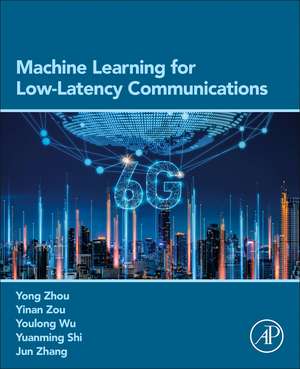Machine Learning for Low-Latency Communications
Autor Yong Zhou, Yinan Zou, Youlong Wu, Yuanming Shi, Jun Zhangen Limba Engleză Paperback – 15 oct 2024
Lastly, three learning to optimize methods for processing latency reduction are given which leverage graph neural networks, multi-agent reinforcement learning, and domain knowledge. Low-latency communications attracts considerable attention from both academia and industry, given its potential to support various emerging applications such as industry automation, autonomous vehicles, augmented reality and telesurgery. Despite the great promise, achieving low-latency communications is critically challenging. Supporting massive connectivity incurs long access latency, while transmitting high-volume data leads to substantial transmission latency.
- Presents the challenges and opportunities of leveraging data and model-driven machine learning methodologies for achieving low-latency communications
- Explains the principles and practices of modern machine learning algorithms (e.g., algorithm unrolling, multiarmed bandit, graph neural network, and multi-agent reinforcement learning) for achieving low-latency communications
- Gives design, modeling, and optimization methods for low-latency communications that apply appropriate learning methods to solve longstanding problems
- Provides full details of the simulation setup and benchmarking algorithms, with downloadable code
- Outlines future research challenges and directions
Preț: 731.70 lei
Preț vechi: 959.57 lei
-24% Nou
Puncte Express: 1098
Preț estimativ în valută:
140.05€ • 152.18$ • 117.72£
140.05€ • 152.18$ • 117.72£
Carte tipărită la comandă
Livrare economică 14-28 aprilie
Preluare comenzi: 021 569.72.76
Specificații
ISBN-13: 9780443220739
ISBN-10: 0443220735
Pagini: 216
Dimensiuni: 191 x 235 mm
Greutate: 0.4 kg
Editura: ELSEVIER SCIENCE
ISBN-10: 0443220735
Pagini: 216
Dimensiuni: 191 x 235 mm
Greutate: 0.4 kg
Editura: ELSEVIER SCIENCE
Cuprins
Part 1: Introduction and Overview
1. Introduction and overview
Part 2: Learning to Estimate for Access Latency Reduction
2. Learning to estimate via group-sparse based algorithm unrolling
3. Learning to estimate via proximal gradient-based algorithm unrolling
4. Learning to detect via multiarmed bandit (MAB)
Part 3: Learning to Compress for Transmission Latency Reduction
5. Learning to compress via information bottleneck
6. Learning to compress via robust information bottleneck with digital modulation
7. Learning to compress for multi-device cooperative edge inference
Part 4: Learning to Optimize for Processing Latency Reduction
8. Learning to optimize via graph neural networks
9. Learning to optimize via knowledge guidance
10. Learning to optimize via decentralized multi-agent reinforcement learning
Part 5: Conclusions
11. Conclusions and Future Research Directions
1. Introduction and overview
Part 2: Learning to Estimate for Access Latency Reduction
2. Learning to estimate via group-sparse based algorithm unrolling
3. Learning to estimate via proximal gradient-based algorithm unrolling
4. Learning to detect via multiarmed bandit (MAB)
Part 3: Learning to Compress for Transmission Latency Reduction
5. Learning to compress via information bottleneck
6. Learning to compress via robust information bottleneck with digital modulation
7. Learning to compress for multi-device cooperative edge inference
Part 4: Learning to Optimize for Processing Latency Reduction
8. Learning to optimize via graph neural networks
9. Learning to optimize via knowledge guidance
10. Learning to optimize via decentralized multi-agent reinforcement learning
Part 5: Conclusions
11. Conclusions and Future Research Directions
